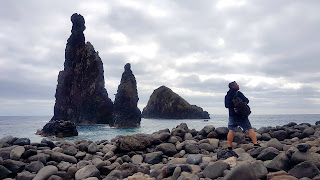Ely10 Birding
A celebration of birding and natural history, generally within a 10 mile radius of Ely Cathedral, Cambridgeshire, UK. It would be great if you wanted to share your Ely 10 birding news, experiences, photos, art and video through this blog. Please contact hairyfolkster@gmail.com with your post or to join the authorship, I'll get you on the list quicker than a fly over Alpine Swift.
Monday, 10 February 2025
Going Dutch
Wednesday, 13 November 2024
On the Wanamangura in the Dream Time.
I had originally intended to tell the tale of our trip to Australia, via the personal and revelatory diaries of Alan Bushman - an intrepid explorer who, in the early days of 2021, discovered the never-before-seen and perfectly exquisite ornithological marvels of the West Coast - relying on nothing but cans of coke, sweat, and his trusty porters, Janice and Hillary. Braving the hot steamy nights, naked under a flimsy mosquito net, fuelled by cigarettes and various viruses and the obsessive desire to lay eyes on, and eventually capture, the legendary B'Toon. It would have been hilarious. And probably very, very racist. And sexist.
Well. It turns out that I simply cannot do justice to Alan within the restrictions of this simple medium, and so, instead, I shall present here a pictorial journey in five parts - a symphony of sights and smells and sounds and the odd rock here and there. Here then, is Alan Bushman the Musical.
Monday, 2 September 2024
One Ringing to rule them all, and in the Darkness bind them
The silver skin of dawn parted the darkened reed lined avenue. Up ahead , a point of pink energy. Hanging, loaded with mechanical intent, ready to spark. It had com to this. This thing, like a gaping yaw, at once there and not there - visible only to the touch. Softness blurring boundaries of dimension. It was the very ground, and it would emerge and engulf the universe, leading its mortal armies of the night - the Path Finder. The Machine of the Night. The Eye.
Thursday, 30 May 2024
Fenland Nature
Morrocco 2014
Madeira 2022
Saturday, 15 July 2023
Fenland Nature
The long gap between my posts on Ely10 birding is due to an exciting project that I have been working on. Simon Stirrup has been gathering stunning images and I have been writing text for a book, to be published by natural history specialists Pelagic, provisionally titled Fenland Nature.
Sunday, 11 December 2022
Frosti
An amble around Roswell Pits produced little out of the ordinary and a hopeful check around the sewage works revealed just 5 Chiffchaff, all collybita.
A return to the Beet Pits for the harrier roost revealed around 20 Marsh Harrier and a bonus Bittern. The evening sky was stunning but despite seeing a Woodcock flying from the fields to the water meadows during the day I didn't see any in my dusk search along the bank, although Snipe were flying around in some numbers.
Sunday, 4 December 2022
Grey Skies
Thursday, 1 December 2022
One Day Like This a Year Will See Me Right.
A few local trips out to the Washes, where Short-eared Owls had been notable highlights, preceeded a weekend away on the Norfolk coast.
Wednesday, 12 October 2022
Migration
Saturday, 3 September 2022
Corcovado
Everything But The Girl - Corcovado - YouTube
I'd planned a visit to Madeira, to fall before the tubenose altar, prior to the global pandemic but it's taken a few years to get back to doing something about it. In the meantime the many hours of UK seawatches and pelagics have been exhilarating and delivered far beyond my hopes with Fea's and Wilson's Petrels in the South West and an Albatross and White-billed Diver in the North Sea amongst all the shearwaters, terns, incoming passerines and the odd Sabine's Gull.
Our seabirding on Maderia fell into 3 types - Seawatches, pelagics and nocturnal breeding site visits. We went out on 3 long pelagic trips with Windbirds which allowed for fantastic views of seabirds both in transit to our chumming points and when working the oily slicks. Seawatching gave us fantastic and repeated experience with seeing petrels and shearwaters in a different context - we seawatched daily from just after dawn and we only encountered Barolo's Shearwater through this approach, trawling through large feeding flocks of shearwaters drawn to pods of Dolphin's. A highlight, amongst many highlights, of the trip was being guided to the Zino's Petrel breeding cliffs high in the mountains. The experience was magical but taking the plunge to buy a thermal imaging camera for this made for something exceptional. Using the camera we could not only hear the haunting wails of the petrels, we could look down the sheer cliff face and see Zino's Petrels emerging from the cloud below us and hang and dance upon the ferocious updraft of the cliff. We used our ears and the camera at Ponta do Garajau to enjoy Cory's Shearwaters flying around their small colony, the air filled with crazy loon calls. Braving the rocky outcrop at the end of the path we were overjoyed to hear the finger rubbing on glass squeeks of Madieran Storm Petrel hopefully returning to breeding spots. A video will follow in time but here are some pics to whet the appetite.
The Stage
Madeira is rugged and dramatic in it's scenery, we bumped into some great vista's and coastline and sunsets during our birding.


The Stars
Desertas Petrel
This chunky bird with a beast of a bill is very likely to be a Deserta's Petrel. Every Pterodroma experience is an adrenaline laced tingle fest. We had many visits from birds on the boat and seawatching produced many birds from land - reliving that UK find over and over again was delicious.
Great Shearwater









































_edited.jpg)
_edited.jpg)
_edited.jpg)
_edited.jpg)
_edited.jpg)
.jpg)
_edited.jpg)
_edited.jpg)
_edited.jpg)
_edited.jpg)
_edited.jpg)
_edited.jpg)
_edited.jpg)
_edited.jpg)
_edited.jpg)
_edited.jpg)
_edited.jpg)
_edited.jpg)
_edited.jpg)

_edited.jpg)
_edited.jpg)
_edited.jpg)



.jpg)




.jpg)
.jpg)
.jpg)
.jpg)
.jpg)
.jpg)
.jpg)